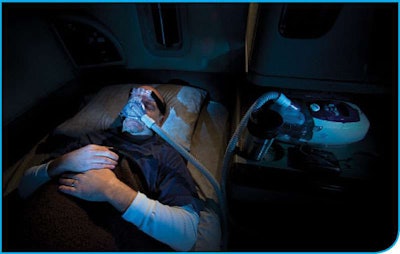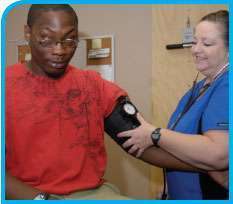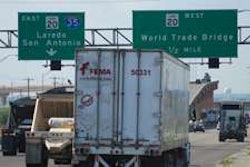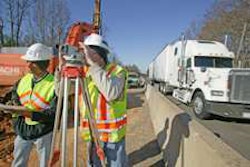Coming regulations would force reckoning with a condition common to truckers. And that’s not all that could make passing the medical exam even harder.
Pending regulatory initiatives could make it much more difficult for truckers, especially those with obstructive sleep apnea, to obtain or renew a medical certificate.
 Since FMCSA’s Medical Review Board formed in 2005, regulators have advocated more scrutiny of conditions such as obstructive sleep apnea, which can be treated in-cab with use of continuous positive airway devices like the one shown here.
Since FMCSA’s Medical Review Board formed in 2005, regulators have advocated more scrutiny of conditions such as obstructive sleep apnea, which can be treated in-cab with use of continuous positive airway devices like the one shown here.One apnea proposal would tie a Body Mass Index threshold to mandatory testing. Another would disqualify drivers on certain apnea-related scenarios, such as refusing treatment.
The creation of a National Registry of Certified Medical Examiners also promises to be a major regulatory move. A final rule on it was expected to be announced by the end of January.
Such certification would considerably reduce doctor shopping by truckers in poor health because only certified examiners, who would be trained and tested, could issue a CDL medical certificate.
The registry will also bear on sleep apnea because drivers can expect more unified testing of the disorder once the registry goes into effect, along with precise guidelines for obstructive sleep apnea screening.
 Examiner trainers urge truckers to be aware of their basic health conditions, especially knowing your blood pressure, such as Jackson, Miss.-based trucker Fred McGee, prepares to find out at Workforce Testing in Tuscaloosa, Ala.
Examiner trainers urge truckers to be aware of their basic health conditions, especially knowing your blood pressure, such as Jackson, Miss.-based trucker Fred McGee, prepares to find out at Workforce Testing in Tuscaloosa, Ala.Regulators “are trying to get standard guidelines out there so that the examiners in the National Registry will share a common guideline,” says industry analyst Tom Bray at J.J. Keller & Associates. Some doctors screen aggressively for the disorder, currently grouped with respiratory function under the Federal Motor Carrier Safety Regulations. Others “aren’t screening for it at all,” Bray says. “Some examiners aren’t even aware of it.”

Two recommendations drafted as guidance to an eventual final rule regulating obstructive sleep apnea were formed in December by the Federal Motor Carrier Safety Administration’s Medical Review Board and Motor Carrier Safety Advisory Committee. The panels said that a driver with a BMI of 35 or higher must be screened for the disorder. The second guidance disqualifies drivers who refuse treatment, report excessive daytime sleepiness, have had an accident after falling asleep, have apnea-hypopnea index scores of 20 or higher, or await evaluation after corrective apnea surgery.
A subcommittee of the panels was expected to submit to FMCSA a rule proposal relative to the condition as early as February. Though it could take years for a proposed rule to culminate in a final rule on screening, testing, treating and monitoring for the sleep disorder, truckers should expect a version of the guidance recommendations to become standard guidelines much sooner, observers say.
Adoption of the proposed guidances has been compared to the pilot program exemption for drivers with insulin-treated diabetes. Though no formal rule exists, that program has been in effect since 2005.
“The issuance is going to have some teeth,” says John McElligott, physician and longtime medical examiner at Occupational Health Services in Knoxville, Tenn., of standard guidelines. His clinic has stocked extra equipment for treating the sleep disorder in anticipation of tougher standards, he says.
Sound sleep is difficult for those with sleep apnea, which deprives the body of oxygen and causes fatigue. An estimated 30 percent of truckers have the disorder, which has figured in some fatigue-related accidents. In December, a settlement in a case against Celadon Group said that sleep apnea was related to a highway death. A jury awarded a Texas family more than $3 million. The driver who crashed had been diagnosed with the condition yet remained untreated for it.
Owner-operators have many of sleep apnea’s risk factors, which include being male, overweight and older than 50. Nearly 30 percent of truckers are obese, and many of them also are at risk for or have cardiovascular disease, hypertension and diabetes. all of which are exacerbated by sleep apnea makes worse and can impede driver certification.
Drivers often are reluctant to be tested for sleep apnea. They fear a carrier won’t hire them, that they will be taken out of service or that treatment will be too time-consuming and costly. The Owner-Operator Independent Drivers Association questions what may be “unneeded expenses,” making it “harder for drivers with the condition to have the freedom of choice of employers,” says OOIDA spokeswoman Norita Taylor. She notes anyone with symptoms of the disorder should seek medical advice.
Drivers with moderate to severe sleep apnea that interferes with safe driving can be disqualified if a state-licensed medical examiner decides they should not drive. While medicines cannot treat the disorder, continuous positive airway pressure (CPAP) machines keep users’ airways open during sleep with use of a face mask.
Some trucking advocates say no hard evidence shows sleep apnea causes crashes, but others point to crashes caused by fatigue, a major symptom of sleep apnea. In 2010, 3,675 fatalities involved trucks, including Class 8 rigs and smaller, according to the U.S. Department of Transportation. An estimated 500 of those deaths involved a fatigued trucker, FMCSA head Anne Ferro says.
Charles Czeisler, chief of Harvard Medical School’s sleep medicine division, says 20 percent of all highway crashes are related to fatigue. He served on the Medical Review Board panel that developed proposed sleep apnea guidelines in 2008. He says drivers with a BMI of 30 or higher – not 35 or higher – should be screened for the disorder.
Czeisler is weary of FMCSA’s decades of indecision on a rule that would regulate the disorder and the screening for it, though he notes that the National Registry will be “a key in making the roads safer.”
Experts familiar with driver health regulation say one of the surest ways for truckers to stay on the road is to take responsibility for their health. Regarding sleep apnea, “The no-cost solution is weight loss,” says Ben Hoffman, Medical Review Board chair. “Changing lifestyle is the solution.”
Anne-Marie Puricelli, a veteran CDL medical examiner and trainer with Concentra Medical Center, in Maryland Heights, Mo., agrees. Truckers “need to focus on improving their health in terms of losing weight, exercising and getting conditions tested,” she says. “Right now there is a big focus on improving the health of the drivers who have sleep apnea, and they might as well do it themselves before they’re told they have to do it.”
Truckers who’ve sought sleep apnea treatment have found that CPAP machines produce quick results. “Most of them come back to us and thank us for treating them,” she says.
One of the smartest changes for smokers is to stop smoking. Its associated health care costs are high and it exacerbates sleep apnea, as well as other conditions, says Bob Rose of J.J. Keller & Associates. “Owner-operators concentrate on their business, but they also have to concentrate on their health. Their return on the investment will prove itself.”
Registry will raise the standard on medical exams
Even apart from expected tighter standards regarding sleep apnea, the National Registry of Certified Medical Examiners could curtail the driving force. This would happen both by requiring tougher nationwide minimum standards for medical exams and by screening out medical professionals who now take a lax approach in approving medical certificates.
Announcement of a final rule creating the registry is expected soon. Carriers with 50 drivers or more will be required to use certified medical examiners two years after the final rule becomes effective. All other drivers and carriers will have three years.
“It will set the bar a little higher in terms of medical examiners,” says Anne-Marie Puricelli, a veteran CDL medical examiner.
Chiropractor Clinton Smith, president of NRCME Training Systems in Breese, Ill., concurs. “It’s going to corral all the examiners and truckers,” Smith says. “There are too many loopholes,” he says of current procedures for selecting examiners. He points out that dangerous drug and alcohol levels too often go unreported. “There will be more accountability.”
Chiropractic physicians, medical and osteopathic doctors, advanced nurse practitioners and physician assistants may still become certified medical examiners, according to the docket for the final rule. An examiner will have to take eight hours of training and be tested on it to become certified. Retraining would be required every three to five years.
Every month examiners will report DOT medical exam results to FMCSA. Carriers will be required to verify drivers’ health certificates that are signed by an examiner in the registry. For more information on the system, visit nrcme.fmcsa.dot.gov/about.aspx.
Drivers who live in rural regions initially might have difficulty finding certified examiners close by. “But by implementing the registry slowly, the hope is that enough examiners will sign up,” Smith says. Currently about 200,000 examiners conduct tests, he says. That number is expected to drop due to the time and cost of becoming certified, but longtime observers say that 40,000 examiners will suffice for the program to function.
Truckers, especially in rural areas, also can expect to pay $100 to $120 for the exam, which often costs $60 to $75 now. “Just based on supply and demand, the assumption is that for truckers in areas where there is no competition and until the examiners pool builds up, there may be some initial higher costs,” Smith says.
The National Registry also will input drivers’ exam results into the national driver database, as part of the system that merges driver medical records with CDL records, which began in January. “This whole thing is dovetailing, implemented in stages, to have one large driver database,” Smith explains.
For a listing by state of medical examiners who paid to be included in an online directory, go to teamcme.com.
Advances for sleep apnea treatment
The most common successful treatments for obstructive sleep apnea are breathing devices. The sleeper wears a mask hooked to a machine that pushes air into the lungs — either a CPAP (continuous positive airway pressure) or APAP (auto-titrated airway pressure) machine.
For patients with mild to moderate apnea, dental devices can help by moving the lower jaw forward.
A new treatment involving a tiny surgical implant under the skin is being tested at Tampa General Hospital’s Sleep Disorder Center, says Dr. William McDowell, who heads the center. He notes that, generally, costs for diagnosing sleep apnea in-lab and monitoring devices for treating the condition are decreasing. Weight loss, the least expensive treatment, has also been shown to help, he says.
McDowell and Duke Naipohn, CEO of sleep apnea treatment provider SleepPointe, based in Wichita, Kan., urge drivers to be tested and treated if diagnosed with the potentially dangerous disorder. “We’re going to have drivers who will have to deal with this. It’s hit the radar, and it’s not going away,” Naipohn says.
SleepPointe is one of several sleep providers that have helped carriers develop fatigue management programs in the last several years. Prime Inc. and Schneider National started programs years ago. J.B. Hunt, Swift Transportation Corp., Crete Carrier Corp., H.O. Wolding and Ryder System Inc. are among fleets that have recently partnered with sleep labs to treat drivers.
Trucker Bob Stanton, who heads the A.W.A.K.E. network of the American Sleep Apnea Association, at awake.truckersforacause.com, tells drivers to take the time to see a doctor: “If you think you’ve got sleep apnea, get tested. If you’ve been diagnosed with it, you need to be treated before you drive again.”
Visit understandingsleep.org for details on screening and treatment.
Sleep apnea signs
These symptoms and related conditions often indicate sleep apnea:
• Excessive, loud snoring or snorting
• Interrupted sleep
• Obesity (a body mass index of more than 30)
• Large neck (17 inches for men, 15.5 inches for women)
• Short sleep periods
• Daytime drowsiness
• Frequent nighttime urination
• Soft throat tissue
• Hypertension
• Reduced libido
• Cigarette smoking













